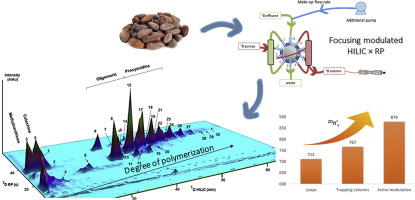当前位置:
X-MOL 学术
›
Anal. Chim. Acta
›
论文详情
Our official English website, www.x-mol.net, welcomes your feedback! (Note: you will need to create a separate account there.)
Characterization of secondary metabolites from green cocoa beans using focusing-modulated comprehensive two-dimensional liquid chromatography coupled to tandem mass spectrometry
Analytica Chimica Acta ( IF 6.2 ) Pub Date : 2018-12-01 , DOI: 10.1016/j.aca.2018.06.068 Said Toro-Uribe , Lidia Montero , Luis López-Giraldo , Elena Ibáñez , Miguel Herrero
Analytica Chimica Acta ( IF 6.2 ) Pub Date : 2018-12-01 , DOI: 10.1016/j.aca.2018.06.068 Said Toro-Uribe , Lidia Montero , Luis López-Giraldo , Elena Ibáñez , Miguel Herrero

|
Proanthocyanidins as well as other secondary metabolites present in green cocoa beans were studied thanks to a new method involving the use of on-line comprehensive two-dimensional liquid chromatography coupled to tandem mass spectrometry (LC × LC-MS/MS). In order to enhance the performance of previously developed methodologies, the use of different modulation strategies were explored. Focusing modulation clearly allowed the attainment of higher resolving power and peak capacity compared to non-focusing modulation set-ups. Moreover, the use of active modulation by the addition of a make-up flow efficiently helped to compensate for the solvent strength mismatch produced between dimensions. The optimized method was useful to successfully describe the secondary metabolite composition of green cocoa that was characterized by the presence of 30 main compounds, including 3 xanthines, 2 flavan-3-ols and 24 oligomeric procyanidins with a degree of polymerization up to 12. The obtained results showed that the proanthocyanidins found in the cocoa beans were exclusively B-type procyanidins. The existence of (epi)catechin subunits linked to sugar or galloyl moieties was not observed. The developed method produced a good separation of secondary metabolites allowing an improvement with respect to the available methodologies for the analysis of a complex food sample such as cocoa metabolites in terms of speed of analysis, resolution and peak capacity.
中文翻译:

使用聚焦调制的综合二维液相色谱与串联质谱联用对绿色可可豆的次级代谢物进行表征
由于采用在线综合二维液相色谱与串联质谱联用 (LC × LC-MS/MS) 的新方法,研究了原花青素以及绿色可可豆中存在的其他次生代谢物。为了提高先前开发的方法的性能,探索了不同调制策略的使用。与非聚焦调制设置相比,聚焦调制显然可以实现更高的分辨率和峰值容量。此外,通过添加补充流使用主动调制有效地有助于补偿尺寸之间产生的溶剂强度不匹配。优化的方法有助于成功描述绿色可可的次级代谢物组成,其特征在于存在 30 种主要化合物,包括 3 种黄嘌呤、2 种黄烷-3-醇和 24 种聚合度高达 12 的低聚原花青素。结果表明,可可豆中发现的原花青素完全是 B 型原花青素。未观察到与糖或没食子酰基部分连接的(表)儿茶素亚基的存在。开发的方法可以很好地分离次级代谢物,从而在分析速度、分辨率和峰容量方面改进了分析复杂食品样品(如可可代谢物)的现有方法。2个flavan-3-ols和24个聚合度高达12的低聚原花青素。所得结果表明可可豆中发现的原花青素完全是B型原花青素。未观察到与糖或没食子酰基部分连接的(表)儿茶素亚基的存在。开发的方法可以很好地分离次级代谢物,从而在分析速度、分辨率和峰容量方面改进了分析复杂食品样品(如可可代谢物)的现有方法。2个flavan-3-ols和24个聚合度高达12的低聚原花青素。所得结果表明可可豆中发现的原花青素完全是B型原花青素。未观察到与糖或没食子酰基部分连接的(表)儿茶素亚基的存在。开发的方法可以很好地分离次级代谢物,从而在分析速度、分辨率和峰容量方面改进了分析复杂食品样品(如可可代谢物)的现有方法。
更新日期:2018-12-01
中文翻译:

使用聚焦调制的综合二维液相色谱与串联质谱联用对绿色可可豆的次级代谢物进行表征
由于采用在线综合二维液相色谱与串联质谱联用 (LC × LC-MS/MS) 的新方法,研究了原花青素以及绿色可可豆中存在的其他次生代谢物。为了提高先前开发的方法的性能,探索了不同调制策略的使用。与非聚焦调制设置相比,聚焦调制显然可以实现更高的分辨率和峰值容量。此外,通过添加补充流使用主动调制有效地有助于补偿尺寸之间产生的溶剂强度不匹配。优化的方法有助于成功描述绿色可可的次级代谢物组成,其特征在于存在 30 种主要化合物,包括 3 种黄嘌呤、2 种黄烷-3-醇和 24 种聚合度高达 12 的低聚原花青素。结果表明,可可豆中发现的原花青素完全是 B 型原花青素。未观察到与糖或没食子酰基部分连接的(表)儿茶素亚基的存在。开发的方法可以很好地分离次级代谢物,从而在分析速度、分辨率和峰容量方面改进了分析复杂食品样品(如可可代谢物)的现有方法。2个flavan-3-ols和24个聚合度高达12的低聚原花青素。所得结果表明可可豆中发现的原花青素完全是B型原花青素。未观察到与糖或没食子酰基部分连接的(表)儿茶素亚基的存在。开发的方法可以很好地分离次级代谢物,从而在分析速度、分辨率和峰容量方面改进了分析复杂食品样品(如可可代谢物)的现有方法。2个flavan-3-ols和24个聚合度高达12的低聚原花青素。所得结果表明可可豆中发现的原花青素完全是B型原花青素。未观察到与糖或没食子酰基部分连接的(表)儿茶素亚基的存在。开发的方法可以很好地分离次级代谢物,从而在分析速度、分辨率和峰容量方面改进了分析复杂食品样品(如可可代谢物)的现有方法。



























 京公网安备 11010802027423号
京公网安备 11010802027423号